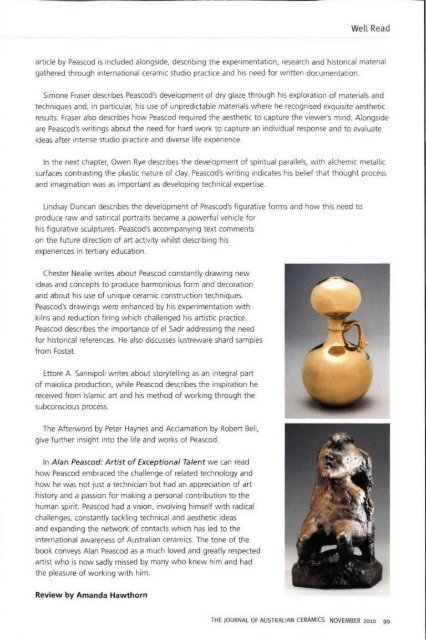The Journal of Australian Ceramics Vol 49 No 3 November 2010
Create successful ePaper yourself
Turn your PDF publications into a flip-book with our unique Google optimized e-Paper software.
Archive: Pottery in Australia. <strong>Vol</strong> 23. <strong>No</strong> 2. <strong>No</strong>vember Decem ber 1984<br />
the primary ways in which Australia can seek the<br />
identity <strong>of</strong> a particular culture is through the work<br />
01 its artists and c raitsworkers.<br />
Obviously . that aspiration alone does not<br />
guarantee the quality <strong>of</strong> the final result. We<br />
artists or designers are accustomed to live on<br />
takmg risks : they are risks. however, founded<br />
upon the hope that something better may eventually<br />
result. In working together for well-stated<br />
purposes, those hopes seem to be more substantial.<br />
more encompassing in time. Our expec·<br />
tations about architecture and the crafts are<br />
drfferent today from those in the time ot Wilham<br />
Morris and John Ruskin. <strong>The</strong> Arts and Crall<br />
Movement <strong>of</strong> that period had different moti·<br />
vations. Our understanding <strong>of</strong> architecture is past<br />
the point 01 being a linite, stylistically rigid obleCt<br />
on which works <strong>of</strong> art, however large in size.<br />
have only a role <strong>of</strong> mere commentary or. at the<br />
opposite extreme, in which the details are can ·<br />
fined to the abstract perfection <strong>of</strong> machine<br />
extrusions.<br />
Those were perhaps the standards 01 modernism<br />
which were idealistic just as post-modernlsm is<br />
political, and which were authoritarian. a spiring,<br />
and aiming for the best in modernism, just as<br />
post·modernism is ana rchistic . aimless. and<br />
searching for the popular. Words like 'modernism'<br />
and 'post-modernism ' sound nice: probably they<br />
are there 10 help. But I am less and less sure<br />
01 what modernism and post-modernism are. In<br />
architecture and in art we must search for something<br />
beyond those tenuous connections that<br />
words make to the things they intend to deSCribe .<br />
All 1 know is that we are searching for more<br />
innate connectIOns that bring us closer to the<br />
places 01 our beginnings. <strong>The</strong> work 01 cralts·<br />
workers is able to suggest those connections.<br />
and their work is an aid in collaborating toward<br />
an architecture that goes beyond Ruskin's description<br />
01 the 'fury for the Sight <strong>of</strong> new things'<br />
or the singlehanded delivery <strong>of</strong> images mirroring<br />
circumstances. Instead. we are striving lor an<br />
architecture that is generated at the confluence<br />
<strong>of</strong> the work <strong>of</strong> a vast body <strong>of</strong> artists. scholars.<br />
engineers. economists, and so fo rth. all <strong>of</strong> them<br />
having an accurate knowledge <strong>of</strong> their business.<br />
yet also possessing an unaffected imagination<br />
constantly related in the project to each other 's<br />
work. In this vast collaboration. we aU hope to<br />
find a sense <strong>of</strong> worth in doing something thai<br />
is not an end in itself but a true enhancement<br />
ollile Itsell.<br />
In summa ry, during the past three years, we have<br />
had the oppor tunity to come in contact ~i t ~ many<br />
craltsworkers in this country, from the vltahty and<br />
excellence 01 those associated with the Art<br />
Schools and the people associated With cralts<br />
working in the big cities , to that remarka.ble<br />
'gang' ot Tasmanian artists intent on their work<br />
In timber, leather. clay and fabrics. Rather .than<br />
Irom the ephemeral att ractions <strong>of</strong> an ever Imprecise<br />
technology such as those repr esented by<br />
the bUIlding Industry . <strong>Australian</strong> architects may<br />
well find inSpirat ion In the human precISion and<br />
generosity 01 these craftsworkers. In tum. the<br />
craftsworkers themselves may also find that<br />
in integratmg thelf work with architecture. they<br />
may achieve a greater substance In their art.<br />
Rynne Tanton<br />
Wall (1982). Stoneware Clay. modelled and cut<br />
3.6 m x 3.3 m. Client and Archlteel: Depaflment<br />
01 Construction Locallon: Henry House. Launceston.<br />
Photo: Mark BarlkeViclVs.<br />
V/fIcenr McGrath<br />
Wall ( 1979- 80J Clay - Feeneys raku. handbu,Ulormar<br />
drvlded /fI to modular elements. 3 m J( "m. Client:<br />
Altorney·GeneraJ's Depattment. Archltecl: Department<br />
01 Housing and Construction. LocatlOfl: Foyer. Court·<br />
house. Ailce Spflngs. Photo: Gunther DetChmann.<br />
Les Blakebrough<br />
Wall Bannsrs (1982). Stoneware Illes and ta CQue,<br />
screens on sralfl/ess steel supports. Overall size<br />
3 m )( 5 5. m. C1Ienl: Umverslty <strong>of</strong> Ta smania. Loca tIOn<br />
5" Slanley BU/bUry <strong>The</strong>atre. UllIverst'y ot Tasmania.<br />
Photo Ufta Schultze.<br />
Romaldo Giurgola, FRAIA, is lhe sentOr parmer in<br />
MltchelllGiurgola & Thorp, architects tOt the New<br />
Parhament House. Canberra. <strong>The</strong>se remarks were<br />
made at the opening <strong>of</strong> the e)l;hlbilion, Craft Works in<br />
Ausualian Arctutecture . Architecture Gallery. <strong>No</strong>rth<br />
Sydney. organiSed by the Crails Board <strong>of</strong> the Australia<br />
Council.<br />
7t<br />
THE JOURNAL OF AUSTRALIAN CERAMICS NOVEMBER <strong>2010</strong> 97


















